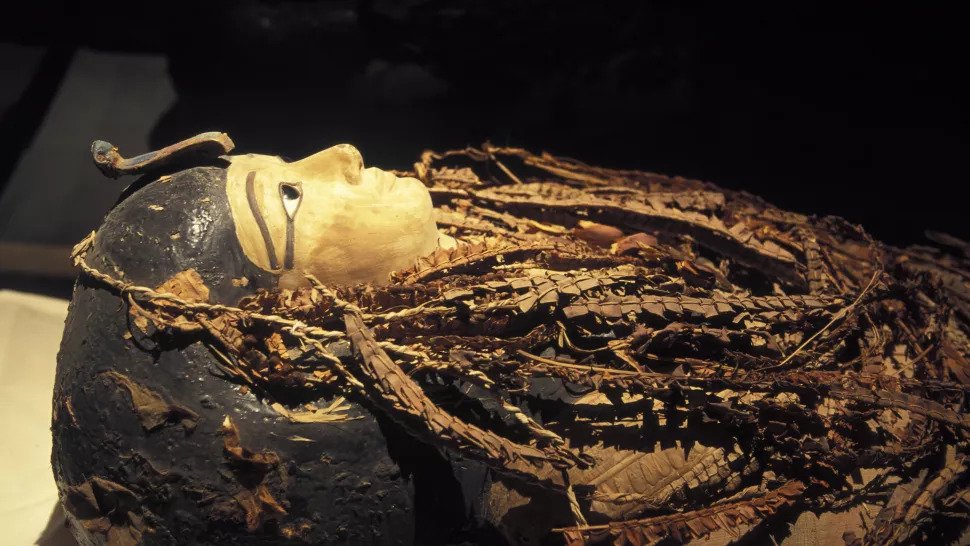For more than three thousand years, the mummy of Amenhotep I, one of ancient Egypt’s most celebrated pharaohs, remained pristinely wrapped, adorned with garlands of flowers and a detailed lifelike mask covering his face. This unique preservation offered a rare glimpse into the burial customs of ancient Egypt, but it also posed a significant challenge. Scientists and researchers hesitated to physically unwrap the mummy due to concerns about causing irreversible damage to its fragile state. Recently, however, technological advancements have provided a groundbreaking solution: a team of researchers utilized CT scans to digitally “unwrap” the mummy, uncovering layers of secrets hidden beneath the ancient wrappings without disturbing the physical remains. This innovative method has allowed researchers to delve into the life, death, and legacy of Amenhotep I in unprecedented detail.

Insights into the Pharaoh’s Life and Death
Through the use of advanced CT scanning technology, researchers were able to gather fascinating insights about Amenhotep I, who ruled Egypt from approximately 1525 B.C. to 1504 B.C. The scans revealed that the pharaoh died at the age of 35, standing at a height of 5.5 feet (169 centimeters). Remarkably, he was found to have been circumcised, a detail consistent with some ancient Egyptian customs, and had exceptionally healthy teeth for someone of his time. Beneath the intricate layers of linen wrappings, the team discovered a treasure trove of artifacts: 30 amulets and a distinctive golden girdle adorned with beads. These items were believed to possess magical properties, aiding the king in his journey to the afterlife, as was customary in ancient Egyptian funerary practices. The presence of these artifacts highlights the significant cultural and spiritual importance placed on the pharaoh’s preparation for the next world.
The Priests’ Loving Restoration
Despite the meticulous mummification process, Amenhotep I’s remains did not escape the perils of tomb robbers, who inflicted considerable damage over the centuries. The scans revealed fractures to his neck, signs of decapitation, and disarticulation of his limbs—injuries likely caused during ancient robberies. However, these findings also unveiled the extraordinary efforts of the 21st dynasty priests, who undertook a loving restoration of the damaged mummy. These priests painstakingly repaired the pharaoh’s remains, skillfully reattaching his severed limbs using resin to hold them in place. They then rewrapped the mummy with fresh bandages, ensuring it retained its original dignity and splendor. This act of restoration underscores the deep reverence and care the ancient Egyptians held for their deceased rulers, even centuries after their initial burial.
A Glimpse into the Pharaoh’s Appearance
The digital unwrapping process not only illuminated the pharaoh’s life and death but also provided a rare glimpse into his physical appearance. Based on the scans, researchers concluded that Amenhotep I bore a striking resemblance to his father, Ahmose I, who was also a prominent pharaoh. Amenhotep I’s facial features included a narrow chin, a small, slender nose, curly hair, and mildly protruding upper teeth. This reconstruction offers a personal and humanizing look at a figure who has long been enshrouded in mystery and myth, bridging the gap between modern viewers and an ancient ruler who lived more than 3,000 years ago.
A Unique Opportunity for Egyptology
Amenhotep I’s mummy represents one of the few royal mummies that had not been physically unwrapped or extensively studied, making it an invaluable resource for Egyptologists. By employing digital technology, researchers were able to examine the mummy’s condition, its intricate mummification process, and the ceremonial items buried alongside the pharaoh. Moreover, this study shed light on the practices of the High Priests of Amun, who not only revered Amenhotep I but also took extraordinary steps to reinter him with great care centuries after his death. The insights gained from this digital exploration extend far beyond the individual, offering a broader understanding of ancient Egyptian funerary rituals, beliefs about the afterlife, and the cultural significance of preserving royal lineage.
This digital unwrapping also marks a pivotal moment in the field of archaeology and Egyptology. Traditional methods of studying mummies often required physical manipulation, which posed significant risks of damage or destruction. By contrast, CT scans provide a non-invasive means of exploration, preserving the integrity of these ancient artifacts while enabling researchers to uncover new information. This breakthrough could serve as a model for studying other mummies and archaeological artifacts, ensuring that history is preserved for future generations.
A Chapter in Ancient Egyptian History
While some scholars have expressed skepticism regarding the significance of these findings, the digital unwrapping of Amenhotep I’s mummy undeniably offers a fascinating chapter in ancient Egyptian history. It illuminates the rich tapestry of rituals, beliefs, and practices surrounding the burial and afterlife of one of Egypt’s most revered rulers. Additionally, it highlights the enduring legacy of the ancient Egyptians’ dedication to their deceased leaders, showcasing their deep cultural respect for the dead and their commitment to ensuring the safe passage of their rulers into the afterlife.
The findings also provide a window into the innovations of modern science and its ability to complement traditional archaeology. By bridging the gap between ancient practices and contemporary technology, researchers have opened new avenues for understanding and appreciating the complexities of ancient civilizations. This study serves as a testament to the enduring allure of ancient Egypt and its capacity to captivate and inspire curiosity, even in the modern era.
The story of Amenhotep I’s mummy is more than just a tale of ancient burial practices; it is a testament to the power of human ingenuity, both ancient and modern. It reveals the lengths to which ancient Egyptians went to honor and preserve their rulers, as well as the advancements modern researchers have made in uncovering the secrets of the past. As technology continues to evolve, it will undoubtedly enable even more discoveries, further unraveling the mysteries of ancient Egypt and enriching our understanding of this remarkable civilization.





